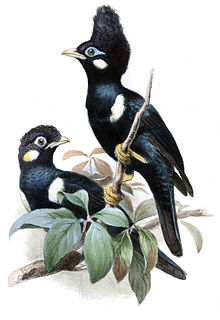
The Philippine creepers or rhabdornises are small passerine birds and form the genus Rhabdornis. They are endemic to the Philippines. They do not migrate, other than to make local movements.

Starlings are small to medium-sized passerine birds in the family Sturnidae. The Sturnidae are named for the genus Sturnus, which in turn comes from the Latin word for starling, sturnus. Many Asian species, particularly the larger ones, are called mynas, and many African species are known as glossy starlings because of their iridescent plumage. Starlings are native to Europe, Asia, and Africa, as well as northern Australia and the islands of the tropical Pacific. Several European and Asian species have been introduced to these areas, as well as North America, Hawaii, and New Zealand, where they generally compete for habitats with native birds and are considered to be invasive species. The starling species familiar to most people in Europe and North America is the common starling, and throughout much of Asia and the Pacific, the common myna is indeed common.

The mynas are a group of birds in the starling family (Sturnidae). This is a group of passerine birds which are native to southern Asia, especially India, Pakistan, Bangladesh and Sri Lanka. Several species have been introduced to areas like North America, Australia, South Africa, Fiji and New Zealand, especially the common myna, which is often regarded as an invasive species.
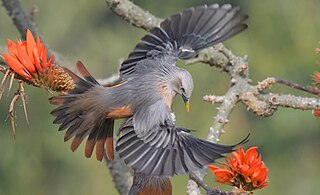
The chestnut-tailed starling, also called grey-headed starling and grey-headed myna is a member of the starling family. It is a resident or partially migratory species found in wooded habitats in India and Southeast Asia. The species name is after the distribution of a former subspecies in the Malabar region. While the chestnut-tailed starling is a winter visitor to peninsular India, the closely related resident breeding population with a white head is now treated as a full species, the Malabar starling.

Acridotheres is a genus of starlings, the "typical" mynas, which are tropical members of the family Sturnidae.

The helmeted myna is a species of starling in the family Sturnidae. It is endemic to Indonesia.
The Apo myna is a species of starling in the starling family Sturnidae. The species is also known as the Mount Apo starling or the Mount Apo king starling. It is the only member of the genus Goodfellowia. It is endemic to the Philippines found only in the tropical montane forests of Mindanao. It is threatened by habitat loss.
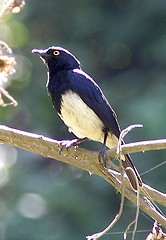
Abbott's starling is a species of starling in the family Sturnidae. It is found in Kenya and Tanzania. Its natural habitat is subtropical or tropical moist montane forests. It is threatened by habitat loss, and its population is estimated at 2500–9999. This species, at 16 to 18 cm long, is the smallest species of starling. It is in the monotypic genus Arizelopsar.

The violet-backed starling, also known as the plum-coloured starling or amethyst starling, is a relatively small species (17 cm) of starling in the family Sturnidae. It is the only member of the genus Cinnyricinclus. This strongly sexually dimorphic species is found widely in the woodlands and savannah forest edges of mainland sub-Saharan Africa. It is rarely seen on the ground, but instead found in trees and other locations away from the ground.

Poeoptera is a genus of bird in the starling family. It contains three species, all live in forest habitats in Africa. These starlings nest in tree cavities, such as old woodpecker or barbet holes. One species, the narrow-tailed starling, nests in colonies. All are birds of the canopy, and their diet is mostly or entirely fruit. Males have a glossier appearance than females.

The grosbeak starling, also known as the grosbeak myna, finch-billed myna, or scissor-billed starling, is a species of starling in the family Sturnidae. It is monotypic in the genus Scissirostrum. It is endemic to Sulawesi, Indonesia.
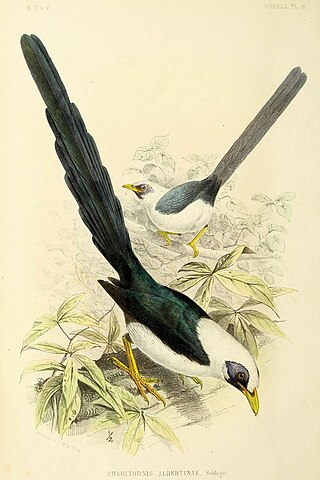
The bare-eyed myna is a large, long-tailed species of starling in the family Sturnidae. Its common name is a reference to the large patch of dark bare skin around the eyes. Due to its superficial resemblance to a magpie, it has been referred to as the Sula magpie in the past. It is endemic to tropical open lowland forests on the Indonesian islands of Taliabu and Mangole in the Sula Islands. It is threatened by habitat loss.

The Burmese myna is a species of starling in the family Sturnidae. It is found in Myanmar and Yunnan, China.

The black-winged myna is a species of starling in the family Sturnidae. The species is also known as the black-winged starling or the white-breasted starling. It is endemic to Indonesia. There are three recognised subspecies: the nominate race, which occurs across much of the island of Java; tricolor, which is restricted to south east Java; and tertius, which is found on Bali and possibly Lombok. The validity of the records on Lombok has been called into question, as there are only a few records and those may represent escapees from the caged-bird trade or natural vagrants. The species has often been assigned to the starling genus Sturnus, but is now placed in Acridotheres because it is behaviourally and vocally closer to the birds in that genus.
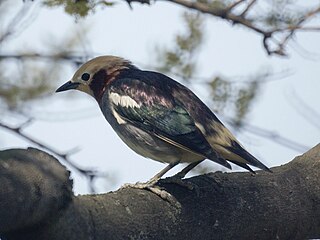
The chestnut-cheeked starling is a species of starling in the family Sturnidae. It breeds in Japan and the Russian islands of Sakhalin and Kuriles; it winters in Taiwan, the Philippines and northern Borneo.

The Daurian starling, or purple-backed starling, is a species of bird in the starling family found in the eastern Palearctic from eastern Mongolia and southeastern Russia to North Korea and central China.

Gracupica is a genus of Asian birds in the family Sturnidae. It is sometimes merged with Sturnus or Sturnia.

Sturnia is a genus of Asian birds in the family Sturnidae. It is sometimes merged with Sturnus.

Mino is a genus of mynas, birds in the starling family. These are the largest of the starlings and are found in tropical moist lowland forests in New Guinea and eastern neighboring islands..

The long-tailed myna is a member of the starling family. It is native to the Bismarck and Solomon archipelagos. It resembles the yellow-faced myna, and the two were formerly considered conspecific.
